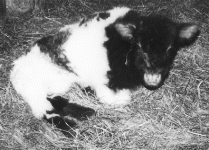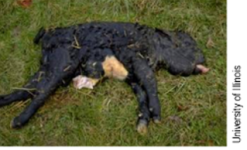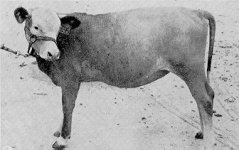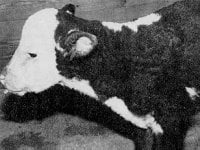jaimiediamond
Well-known member
So I admit to amusing myself on a slow day at work by reading posts and sometimes even seeing fit to comment. I have heard back from a lot of great cattle people some with similar views and a lot with different views. When it comes to any animal operation there will always be different opinions, feelings, and results in situations. With that said I do feel there is one situation we all should if not agree on be fully aware of and educated about. This situation is genetic defects. I have listed a few that I am aware of and I would like to invite other cattle breeders to list ones that they know and I have missed and perhaps pictures  .
.
Tibial Hemimelia commonly known as TH shows the affected limbs are short and twisted, with fused joints. Calves also have large abdominal hernias, an abnormally hairy coat, and deformed skulls. If an affected calf survives birth, it is unable to stand to nurse and should be destroyed. This is a recessive defect which simply means that if a TH carrier is bred to another TH carrier there is a 50% chance that calf born will be a carrier 25% chance it will be free and 25% chance it will be the lethal fatal. TH is now affecting not just Shorthorns but also Simmentals. In the 1960s the Galloway breed eliminated this defect by mating suspected carriers together.
Pulmonary Hypoplasia with Anasarca commonly known as PHA is a lethal genetic condition caused by a recessive mutation. PHA-affected calves are born dead with underdeveloped lungs (Pulmonary Hypoplasia) and swelling caused by excessive fluid retention (Anasarca). These calves are generally so large (over 200lbs) that a C Section is required to deliver them. Again this is a recessive defect which simply means that if a PHA carrier is bred to another PHA carrier there is a 50% chance that calf born will be a carrier 25% chance it will be free and 25% chance it will be the lethal fatal. This defect affect multiple breeds at this time
Hypotrichosis or hairlessness occurs in several breeds of beef cattle. It expresses itself as complete or partial loss of hair. Calves are often born with no hair but will grow a short curly coat of hair with age. Affected individuals are prone to environmental stress and skin infections are more prevalent. Again this is a recessive gene.
Alopecia Anemiais a syndrome has recently been identified in the Polled Hereford breed. At the time of birth, alopecia anaemia may be mistaken for hairlessness. Affected calves are often small at birth, have a dirty-faced appearance, and have protruding tongue and eyes. Hair is wiry, tightly curled or absent while wrinkled skin gives the appearance of advanced aging. Calves are lethargic, cannot tolerate stress and are very prone to disease. Few survive past six months of age. Malfunction of the skeletal structure results in reduced red blood cell production (anaemia). Alopecia anaemia occurs in families but the exact mode of transmission is unknown.
Beta-mannosidosis The result is the birth of calves that never get up and eventually die. The syndrome occurs in the Salers breed and a blood test is available for identifying carriers.The Beta-man disorder is due to a recessive gene that produces a defective enzyme.
Tibial Hemimelia commonly known as TH shows the affected limbs are short and twisted, with fused joints. Calves also have large abdominal hernias, an abnormally hairy coat, and deformed skulls. If an affected calf survives birth, it is unable to stand to nurse and should be destroyed. This is a recessive defect which simply means that if a TH carrier is bred to another TH carrier there is a 50% chance that calf born will be a carrier 25% chance it will be free and 25% chance it will be the lethal fatal. TH is now affecting not just Shorthorns but also Simmentals. In the 1960s the Galloway breed eliminated this defect by mating suspected carriers together.
Pulmonary Hypoplasia with Anasarca commonly known as PHA is a lethal genetic condition caused by a recessive mutation. PHA-affected calves are born dead with underdeveloped lungs (Pulmonary Hypoplasia) and swelling caused by excessive fluid retention (Anasarca). These calves are generally so large (over 200lbs) that a C Section is required to deliver them. Again this is a recessive defect which simply means that if a PHA carrier is bred to another PHA carrier there is a 50% chance that calf born will be a carrier 25% chance it will be free and 25% chance it will be the lethal fatal. This defect affect multiple breeds at this time
Hypotrichosis or hairlessness occurs in several breeds of beef cattle. It expresses itself as complete or partial loss of hair. Calves are often born with no hair but will grow a short curly coat of hair with age. Affected individuals are prone to environmental stress and skin infections are more prevalent. Again this is a recessive gene.
Alopecia Anemiais a syndrome has recently been identified in the Polled Hereford breed. At the time of birth, alopecia anaemia may be mistaken for hairlessness. Affected calves are often small at birth, have a dirty-faced appearance, and have protruding tongue and eyes. Hair is wiry, tightly curled or absent while wrinkled skin gives the appearance of advanced aging. Calves are lethargic, cannot tolerate stress and are very prone to disease. Few survive past six months of age. Malfunction of the skeletal structure results in reduced red blood cell production (anaemia). Alopecia anaemia occurs in families but the exact mode of transmission is unknown.
Beta-mannosidosis The result is the birth of calves that never get up and eventually die. The syndrome occurs in the Salers breed and a blood test is available for identifying carriers.The Beta-man disorder is due to a recessive gene that produces a defective enzyme.




